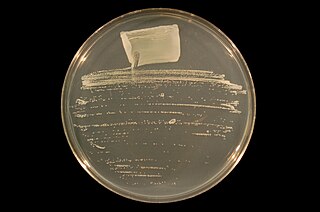Related Research Articles

Agrobacterium is a genus of Gram-negative bacteria established by H. J. Conn that uses horizontal gene transfer to cause tumors in plants. Agrobacterium tumefaciens is the most commonly studied species in this genus. Agrobacterium is well known for its ability to transfer DNA between itself and plants, and for this reason it has become an important tool for genetic engineering.

Thermus is a genus of thermophilic bacteria. It is one of several bacteria belonging to the Deinococcota phylum. According to comparative analysis of 16S rRNA, this is one the most ancient group of bacteria Thermus species can be distinguished from other genera in the family Thermaceae as well as all other bacteria by the presence of eight conserved signature indels found in proteins such as adenylate kinase and replicative DNA helicase as well as 14 conserved signature proteins that are exclusively shared by members of this genus.

Halomonadaceae is a family of halophilic Pseudomonadota.
In taxonomy, Ruegeria is a genus of the Rhodobacteraceae. This genus was formerly known as the marine Agrobacterium before they were reclassified in 1998. It bears in fact the name of Hans-Jürgen Rüger, a German microbiologist, for his contribution to the taxonomy of marine species of Agrobacterium.
Alteromonas is a genus of Pseudomonadota found in sea water, either in the open ocean or in the coast. It is Gram-negative. Its cells are curved rods with a single polar flagellum.

Ensifer is a genus of nitrogen-fixing bacteria (rhizobia), three of which have been sequenced.
In taxonomy, Ahrensia is a genus of the Hyphomicrobiales. Ahrensia is named after the German microbiologist R. Ahrens. The cells are rod-shaped and motile. They are strictly aerobic.
In taxonomy, Stappia is a genus of the Hyphomicrobiales. Some members of the genus oxidize carbon monoxide (CO) aerobically. Stappia indica is a diatom associated bacterium which is known to inhibit the growth of diatoms such as Thalassiosira pseudonana.
Streptoalloteichus is a genus of bacteria within the family Pseudonocardiaceae that contains two known species:

Bacterial taxonomy is subfield of taxonomy devoted to the classification of bacteria specimens into taxonomic ranks.
Afifella is a genus in the phylum Pseudomonadota (Bacteria). Afifella are found in marine and estuarine settings, including microbial mats. They are anaerobes, with one cultured representative capable of photosynthesis.
Dactylosporangium is a genus of bacteria in the phylum Actinomycetota.
Agromyces is a genus in the phylum Actinomycetota (Bacteria).
Hoeflea is a genus of Gram-negative, strictly aerobic, oxidase- and catalase-positive, non-spore-forming, rod-shaped bacteria.
Virgibacillus is a genus of Gram-positive, rod-shaped (bacillus) bacteria and a member of the phylum Bacillota. Virgibacillus species can be obligate aerobes, or facultative anaerobes and catalase enzyme positive. Under stressful environmental conditions, the bacteria can produce oval or ellipsoidal endospores in terminal, or sometimes subterminal, swollen sporangia. The genus was recently reclassified from the genus Bacillus in 1998 following an analysis of the species V. pantothenticus. Subsequently, a number of new species have been discovered or reclassified as Virgibacillus species.
Hoeflea alexandrii is a Gram-negative, oxidase-negative, catalase-positive, non-spore-forming, motile bacteria with a single polar flagella from the genus of Hoeflea which was isolated from Alexandrium minutum AL1V in Vigo in Spain.
Hoeflea phototrophica are aerobic marine bacteria from the genus of Hoeflea which was isolated from a culture of Prorocentrum lima.
Thalassotalea is an aerobic and chemo-organo-heterotrophic genus of bacteria from the family Colwelliaceae which occur in the ocean and in sea ice.
Dokdonia is a genus of bacteria in the family Flavobacteriaceae and phylum Bacteroidota.
Oscillospiraceae, also commonly called Ruminococcaceae, is a family of bacteria in the class Clostridia. All Oscillospiraceae are obligate anaerobes. However, members of the family have diverse shapes, with some rod-shaped and others cocci.
References
- ↑ LSPN lpsn.dsmz.de
- ↑ "Straininfo of Hoeflea marina". Archived from the original on 2014-05-06. Retrieved 2014-03-30.
- 1 2 Peix, A. (2005). "Reclassification of Agrobacterium ferrugineum LMG 128 as Hoeflea marina gen. nov., sp. nov". International Journal of Systematic and Evolutionary Microbiology. 55 (3): 1163–1166. doi: 10.1099/ijs.0.63291-0 . PMID 15879249.
- ↑ Ruger, H. -J.; Hofle, M. G. (1992). "Marine Star-Shaped-Aggregate-Forming Bacteria: Agrobacterium atlanticum sp. nov.; Agrobacterium meteori sp. nov.; Agrobacterium ferrugineum sp. nov., nom. Rev.; Agrobacterium gelatinovorum sp. nov., nom. Rev.; and Agrobacterium stellulatum sp. nov., nom. Rev". International Journal of Systematic Bacteriology. 42 (1): 133–43. doi: 10.1099/00207713-42-1-133 . PMID 1371058.
- ↑ Deutsche Sammlung von Mikroorganismen und Zellkulturen
- ↑ UniProt